|

Summer
1999 (7.2)
Nusrat Hajiyev
(1948- )
Yesterday
and Today, the Same -
We're Just Characters That Change Clothes
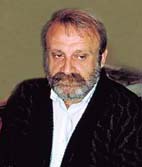  The
intriguing characters in Nusrat Hajiyev's paintings look historical,
but they're not meant to seem old-fashioned. You'll find the
men dressed in baggy Turkish pants and turbans, while the women
wear long dresses and veils, reminiscent of the traditional dress
a century ago. Nusrat doesn't paint this way out of a sense of
nostalgia or sentimentalism, but says, "Life today is still
the same-we merely change our clothes." People wear clothing
designed by Christian Dior today, Nusrat says, but he believes
that their conversations, temperaments and emotions are the same
as in the past. "You'll find someone hiding something from
another person, someone trying to cheat another, and someone
loving another with the same intensity and devotion as Romeo
and Juliet did in the past." Nusrat's fusion of the past
with the present lends a timeless quality to his work. The
intriguing characters in Nusrat Hajiyev's paintings look historical,
but they're not meant to seem old-fashioned. You'll find the
men dressed in baggy Turkish pants and turbans, while the women
wear long dresses and veils, reminiscent of the traditional dress
a century ago. Nusrat doesn't paint this way out of a sense of
nostalgia or sentimentalism, but says, "Life today is still
the same-we merely change our clothes." People wear clothing
designed by Christian Dior today, Nusrat says, but he believes
that their conversations, temperaments and emotions are the same
as in the past. "You'll find someone hiding something from
another person, someone trying to cheat another, and someone
loving another with the same intensity and devotion as Romeo
and Juliet did in the past." Nusrat's fusion of the past
with the present lends a timeless quality to his work.
_____
I remember that when I was about four or five years old and wasn't
yet able to read, I had a book with wonderful illustrations in
it. It was hard to separate me from that book. I used to become
absorbed in those pictures. We were living in Ganja [north central
Azerbaijan] at the time. Later during a move to Baku, the book
was misplaced. It took us a couple of years to finally locate
it, stashed away among some of my parents' books. I immediately
remembered the book and since I could read by then, I found out
that those drawings were made by an Italian artist. That book
was my first introduction to art. Today, illustrating books brings
me the greatest satisfaction of all.
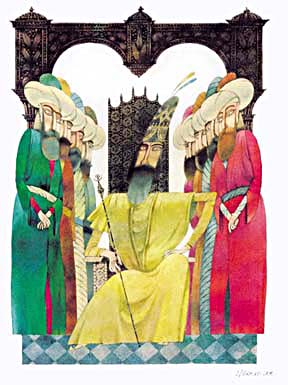  Of
course, I've had many kinds of artistic influences in my life.
My father Suleyman was an architect who was involved with the
theater and occasionally played the role of an artist in plays.
He also made drawings. Elchin Mammad [a distinguished illustrator]
is my relative. The famous Azerbaijani composer Fikrat Amirov
[1922-1984] was my uncle [See Winter 97, AI 5.4]. I also had
an aunt who was an actress. So I became an artist because I realized
there was such a profession, thanks to the people who were part
of my everyday life. Of
course, I've had many kinds of artistic influences in my life.
My father Suleyman was an architect who was involved with the
theater and occasionally played the role of an artist in plays.
He also made drawings. Elchin Mammad [a distinguished illustrator]
is my relative. The famous Azerbaijani composer Fikrat Amirov
[1922-1984] was my uncle [See Winter 97, AI 5.4]. I also had
an aunt who was an actress. So I became an artist because I realized
there was such a profession, thanks to the people who were part
of my everyday life.
Left: Nusrat Hajiyev, "The
Shah", 18 x 25 cm, watercolor on paper, 1998. Packed together
like sardines, the Shah's subjects are passive and servile, expressing
no personalities of their own.
However, it seems to me that primitive man is the most genius
of artisans. He is the one who began the whole process of artistic
expression in the beginning by picking up a stone or sharp object
and drawing his impressions on cave walls. Somehow he had this
urge to create and document the beauty of life around him. He
wasn't just occupied with satisfying his physical needs.
Later when I started attending Baku's Art School (1969-1974),
I had already decided what kind of artwork I wanted to do-watercolor
miniatures related to history and folklore. I drew a lot of inspiration
from 13th- and 14th-century artists such as Soltan Mohammad and
Behzad. They were members of the famous miniature school in Tabriz,
one of the most developed art schools of its time. Soltan Mohammad
brought the portrait genre to this school with works such as
"The Prince with a Book," which is supposed to be a
portrait of the Safavid ruler Tahmasib, who ruled a region that
extended 1 million square kilometers and included Iraq, Iran,
Armenia and Azerbaijan.
At the time, my desire to pursue miniature artwork would have
been considered "nationalistic" and severely reprimanded
and discouraged. Other artists who had tried to express nationalistic
views ran into difficulties and couldn't get their works exhibited.
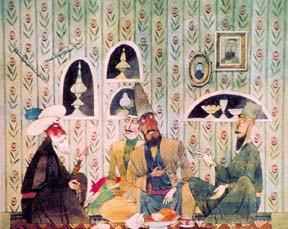  For
example, when I was a student, there used to be art exhibitions
at the Lenin Museum in Baku [now the Carpet Museum]. One day
when I was passing near the Boulevard, I saw Rasim Babayev [see
page 45] walking with his head down and a painting under his
arm. The work, called "Pistachio Tree", had been pulled
from the exhibition that was to open the following day. I still
remember the dejected look on his face. For
example, when I was a student, there used to be art exhibitions
at the Lenin Museum in Baku [now the Carpet Museum]. One day
when I was passing near the Boulevard, I saw Rasim Babayev [see
page 45] walking with his head down and a painting under his
arm. The work, called "Pistachio Tree", had been pulled
from the exhibition that was to open the following day. I still
remember the dejected look on his face.
Left:
Nusrat Hajiyev
"Old Baku", 26 x 22.5 cm, watercolor on paper, 1997.
It was the first indication I had of how things could be for
me in the future. But still artists like Rasim and Kamal Ahmad
[see page 66] used to bring their works to show exactly how they
were working, even if their works were usually rejected. Today,
they are among the most respected artists in our country.
Public vs. Private
I soon learned to make a distinction between public and private
art. I created two kinds of works: one for society and the other
for myself. The first group of works was shown in exhibitions
organized by the Artists' Union. The second group remained privately
in my studio.
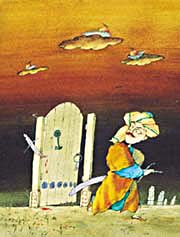  For
my public art, I made posters for exhibitions. They were easy.
Each poster was dedicated to a certain theme. As part of our
homework for art school, we created works for exhibitions around
certain themes. For
my public art, I made posters for exhibitions. They were easy.
Each poster was dedicated to a certain theme. As part of our
homework for art school, we created works for exhibitions around
certain themes.
For example, there were exhibitions dedicated to the October
Revolution, Women's Day or Lenin. A few months prior to each
exhibition, the theme would be identified so that we could start
our work. For my first exhibition in 1972, I depicted Ichari
Shahar (Baku's medieval Inner City).
Left:
Nusrat Hajiyev,
"Malikmammad", 6.25" x 9", watercolor.
In my private collection of art, I created works related to history,
legends and customs. But it was impossible to exhibit them. Only
my relatives and friends saw them. I didn't hide them, nor do
I think anyone would have arrested me if they had seen them.
We didn't have any restrictions as to what themes we could choose.
You could paint or draw anything. You could even bring the works
to an exhibition, but they simply wouldn't be exhibited. I sensed
which works to take to the exhibition and which not to take.
To tell you the truth, the works I paint today would definitely
have been excluded from the exhibitions.
His Approach
I've
loved to read since childhood. When I decided to become an artist,
I wanted so much to have my art appear in books. I think books,
especially children's books, bear
a lot of similarities to miniature art. Children like to read
books with pictures. Since I inject national spirit into the
works that are introduced into children's books, this helps to
foster national spirit within children.
As a book illustrator,
it's critical for me to transfer the spirit of each book into
its graphics. It's not fair to take anything
away from the general spirit of the book. But when I create other
works on my own, I try to contribute my own ideas and imagination.
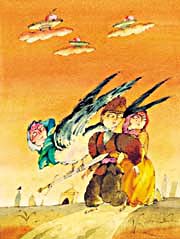  When
I work on something, I try to inject my love into it from the
bottom of my heart. I'm known for being very exacting and paying
very close attention to detail. For instance, sometimes it takes
me two hours just to draw a character's beard. When
I work on something, I try to inject my love into it from the
bottom of my heart. I'm known for being very exacting and paying
very close attention to detail. For instance, sometimes it takes
me two hours just to draw a character's beard.
In terms of adding perspective, I try to make the scene convincing.
That is, those who study my works can identify two schools in
them: both the school of miniatures and the school of contemporary
art.
I don't draw my figures with narrow eyes as they did in the past,
simply because our people do not have narrow eyes. I think the
artist has the responsibility to portray life from his own point
of view. Why should art remain like it was in the past?
Left:
Nusrat Hajiyev,
"The Tale of Yusif", 6.25" x 9", watercolor.
I love humor and really enjoy being around people who have a
sense of humor. That's why I try to add a touch of humor to my
miniatures as well. I think humor is inseparable from intelligence.
The themes I deal with primarily are authority and nationality.
Such issues are eternal. They existed in the past, we experience
them in our everyday lives today and they will exist in the future.
But it's not always easy to portray works from a historical point
of view. Finding resources and references to draw the old costumes
turns out to be quite difficult. There are some traditional costumes
on exhibition at the Tagiyev History Museum, but this is not
enough. My primary source comes from ancient miniatures. I've
also found some books and postcards for references. Most artists
have to resort to their own imaginations. It's difficult to create
old settings, but I think it's important to be as authentic as
possible.
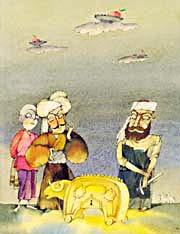  If
you look at the works I did 20 years ago and compare them to
what I do now, you'll see a big difference. Sometimes it's hard
for me to even recognize my own works. Sometimes I don't even
want to remember how I used to draw because I have such a temperament
that usually after finishing a work, the very next day I don't
like it and start being critical of it. If
you look at the works I did 20 years ago and compare them to
what I do now, you'll see a big difference. Sometimes it's hard
for me to even recognize my own works. Sometimes I don't even
want to remember how I used to draw because I have such a temperament
that usually after finishing a work, the very next day I don't
like it and start being critical of it.
Independence
Even
though we have gained our independence, I don't think I will
ever be able to feel completely free. In fact, I don't want to
be free of all responsibilities. I am not living alone somewhere,
isolated on an island. I have my relatives and my children, and
to a certain extent, I depend on them as they do me.
Left: Nusrat Hajiyev, "The
King and the
Blacksmith"
To be independent from a repressive government is a different
issue, but moral dependence is necessary for mankind. We need
our families, our children, our friends and our art. There can
be no such thing as freedom here on earth. If such a thing could
exist, man would be spoiled spiritually. I like the fact that
I need to depend on someone and that I have specific duties towards
them. When I fulfill these duties, I am the happiest man in the
world. The same can be said about art. I am a human being and
I am an artist. They are dependent on each other. When these
two notions merge, they create something unique indeed.
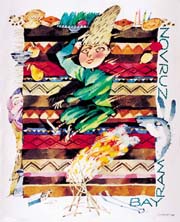  New Challenges New Challenges
Before Azerbaijan's independence, it was difficult to consider
most artists who had gained strong reputations as "real
artists". If the situation hadn't changed, no one would
have known about Azerbaijan's talented dissident artists like
Javad
Mirjavad [page 30] or Kamal. Among their peers, they were very
respected, but among the general population, very few people
knew them. No one even looked at them when they walked down the
street. Meanwhile, the well-known artists who catered to the
government's wishes were given the choice assignments, held high
positions and made decisions about art projects (and who received
the commissions and projects).
Left:
Nusrat Hajiyev,
"Jumping Over the Bonfire at Noruz" (Spring Solstice,
March 21).
Today the situation is much different. We used to be dissatisfied
in the past; it wouldn't be fair to say that we are dissatisfied
today. We aren't, but yet we are. It's just that we have a different
set of difficulties that we have to deal with. It's hard for
average artists to make a living. One needs to be world-class
and extremely talented to become well known. The main problem
now is financial. I'm not talking about buying clothes and things
like that. Sometimes I have to be concerned whether I will even
be able to afford paint.
Still, I think art will continue here in Azerbaijan despite the
difficult economic situation. It's something that can't be stopped.
I remain optimistic about this. In the future I think there will
be fewer artists. Very few parents will urge their children to
become artists. But if a child is born with talent, that talent
will emerge. As a result, in the future, I think the quantity
of works will decrease while the quality increases.
Nusrat Hajiyev
can
be reached at (99-412) 92-15-90 (home) or 76-17-38 (studio).
He has been a member of Azerbaijan's Artists' Union since 1978.
From Azerbaijan
International
(7.2) Summer 1999.
© Azerbaijan International 1999. All rights reserved.
Nusrat Hajiyev | AZgallery Artists
|







